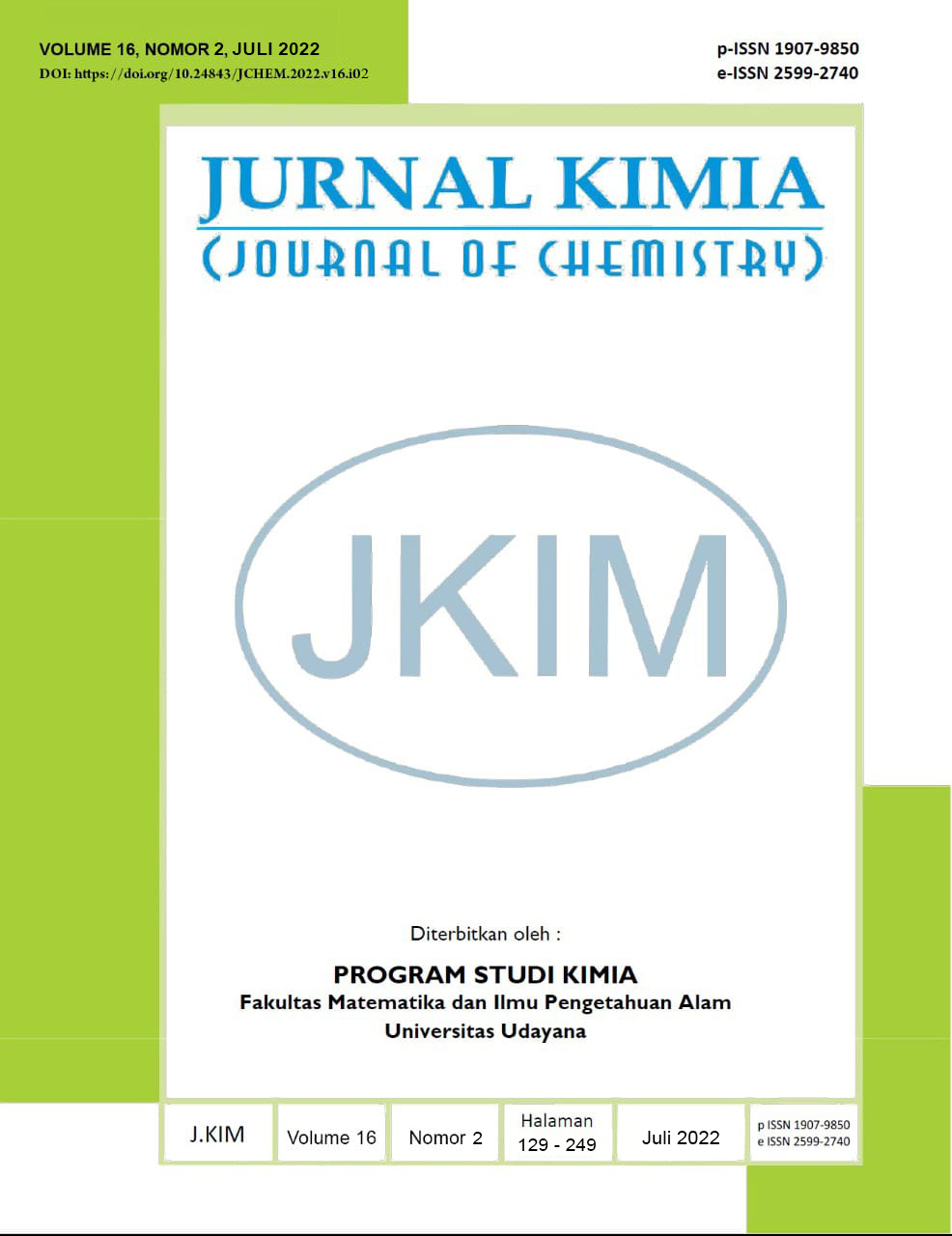BIOAVAILABILITAS DAN BIOAKUMULASI LOGAM Pb DAN Cu PADA CABAI RAWIT (Capsicum annuum L.) DI SUBAK SEMBUNG DENPASAR
Abstract
Penggunaan pupuk dan pestisida anorganik dapat memicu adanya logam berat yang dapat mengkontaminasi lahan pertanian. Tujuan dari penelitian ini adalah mengetahui bioavailabilitas logam Pb dan Cu pada tanah pertanian cabai rawit di perkebunan Subak Sembung Denpasar serta bioakumulasi logam Pb dan Cu pada setiap bagian tumbuhan cabai rawit. Metode yang digunakan untuk menentukan fraksi-fraksi dan bioavailabilitas logam Pb dan Cu adalah metode ekstraksi bertahap sedangkan bioakumulasinya ditentukan dengan metode destruksi yang dikuantifikasi dengan menggunakan Atomic Absorption Spectrometry (AAS). Hasilnya menunjukkan bahwa tanah pertanian di Subak Sembung Denpasar baik sebelum penanaman maupun saat panen mengandung logam Pb dan Cu berturut-turut sebesar 103,2493-188,4113 mg/kg dan 38,3137-59,3514 mg/kg. Bioavailabilitas logam Pb dan Cu dalam tanah didominasi oleh logam yang bersifat berpotensi bioavailable (49,67-88,56% untuk Pb dan 51,49-64,18% untuk Cu), kemudian yang bersifat non bioavailable (8,40-18,67% untuk Pb dan 33,65-46,94% untuk Cu) serta yang terkecil adalah bersifat bioavailable (1,95-12,40% untuk Pb dan 0,41-3,31% untuk Cu). Kandungan logam yang terdistribusi ke setiap bagian tumbuhan berturut-turut pada akar, batang dan buah berturut-turut berkisar 3,05-12,61%; 15,41-16,49% ; 41,73-47,91% dan 30,26-35,25% beruturut-turut untuk Pb dan berkisar 42,87-47,91%; 19,13-33,76%; 17,98-26,12%; 4,54-6,84% berturut-turut pada Cu. Edible part cabai rawit melebihi ambang batas logam Pb berdasarkan nilai yang telah ditetapkan oleh Badan Pengawaas Obat dan Makanan yaitu 0,2 mg/kg.
Kata kunci: Bioavailabilitas, Cu, Pb, cabai rawit.
ABSTRACT
The use of inorganic fertilizers and pesticides can trigger the presence of heavy metals that can pollute agricultural land. The purpose of this study was to determine the bioavailability of Pb and Cu metals in cayenne pepper farms in the Subak Sembung plantation in Denpasar as well as the bioaccumulation of Pb and Cu metals in each part of the cayenne pepper plant. The method used to determine the fractions and bioavailability of Pb and Cu was a squential extraction method, while the bioaccumulation was by the destruction method quantified using the Atomic Absorption Spectrometry (AAS). The results showed that the agricultural land in Subak Sembung Denpasar both before planting and at harvesting contained Pb and Cu metals of 103.2-188.4 mg/kg and 38.3-59.3 mg/kg, respectively. The bioavailability of Pb and Cu in soil was dominated by potentially bioavailable metals (49.67-88.56% for Pb and 51.49-64.18% for Cu), then non-bioavailable (8.40-18.67% for Pb and 33.65-46.94% for Cu) and the smallest was bioavailable (1.95-12.40% for Pb and 0.41-3.31% for Cu). Metal content distributed to each part of the plants, such as Pb in the roots, stems and fruits ranged from 3.05-12.61%, 15.41-16.49%, 41.73-47.91% and 30.26-35.25%, respectively, and for Cu ranged from 42.87-47.91%, 19.13-33.76%, 17.98-26.12%, 4.54-6.84%, respectively. The edible part of cayenne pepper is classified as contaminated with Pb because it exceeds the value set by the Food and Drug Supervisory Agency, which is 0.2 mg/kg.
Keywords: Bioavailability, Cu, Pb, cayenne pepper.
Downloads
References
Alloway, B. J. 1995. Heavy Metals in Soils. 2nd Ed. Glasgow. London
Davidson, C. M,. Duncana, A. L., Littlejohna, D., Urea, A. M., dan Garden, L. M. 1998. A Critical Evaluation of The Three-Stage BCR Sequential Extraction Procedure to Assess The Potential Mobility and Toxicity of Heavy Metals In Industrially-Contaminated Land. Analytica Chimica Acta. 363(1):45-55
Dirjen Pengawas Obat dan Makanan. 2018. Batas Maksimum Cemaran Logam Berat dalam Pangan Olahan. BPOM 2018. Jakarta
Gasparatos, D., Haidouti, C., Adrinopoulos, F., and Areta, O. 2005. Chemical Speciation and Bioavailability of Cu, Zn, and Pb in Soil from the National Garden of Athens, Greece. Proceedings of the 9th International Conference on Enviromental Science and Thechnology. Rhodes Island, Greece, 1-3 September. p. A-438 – A-444
Khaira, K. 2017. Analisis Kandungan Logam Berat Timbal (Pb) pada Cabai Merah (Capsicum annuum L.) yang Beredar di Pasar Batusangkar. Journal of Saintek. 9(2):94-102
Lakitan, B. 2001. Dasar-dasar Fisiologi Tumbuhan. Jakarta: Raja Grafindo Persada.
Ministry of State for Population and Environmental of Indonesia, and Dalhosie, Universitas Canada. 1992. Environmental Management in Indonesia. Report of Soil Quality Standars for Indonesia
Wiryanta, W. T dan Bernardius. 2005. Bertanam Cabai Pada Musim Hujan. Jakarta: Agromedia Pustaka.
Yap, C. K., Imail, K., dan Tan, S. G. 2003. Concentration, Distribution and Geochemical Speciation of Copper in Surface Sediment of the Strait of Malacca. Pak. J. Biol. Sci. 6(12): 1021-1026.

This work is licensed under a Creative Commons Attribution 4.0 International License






